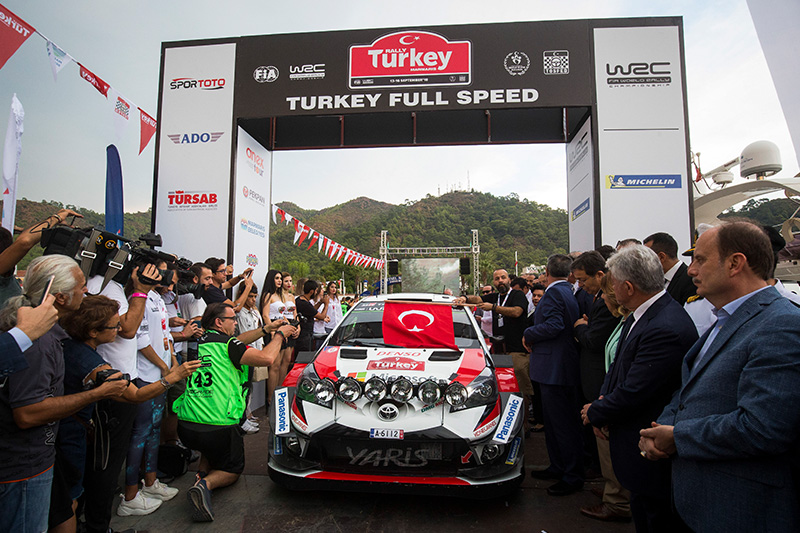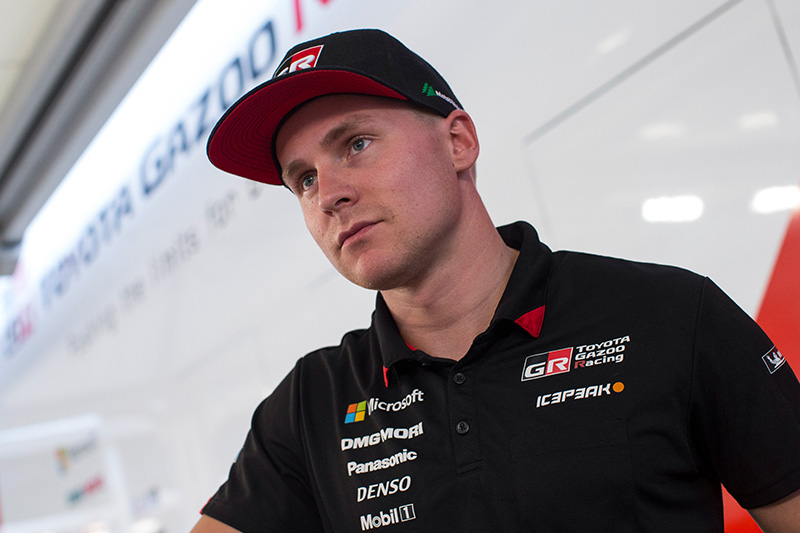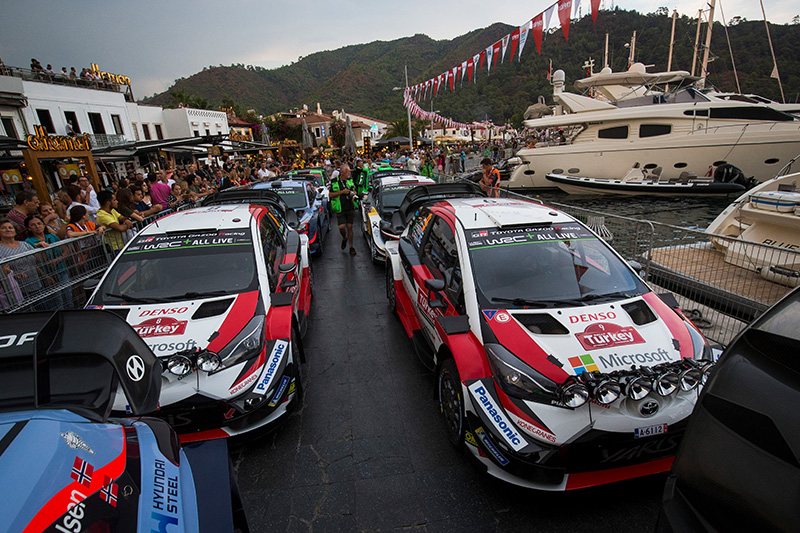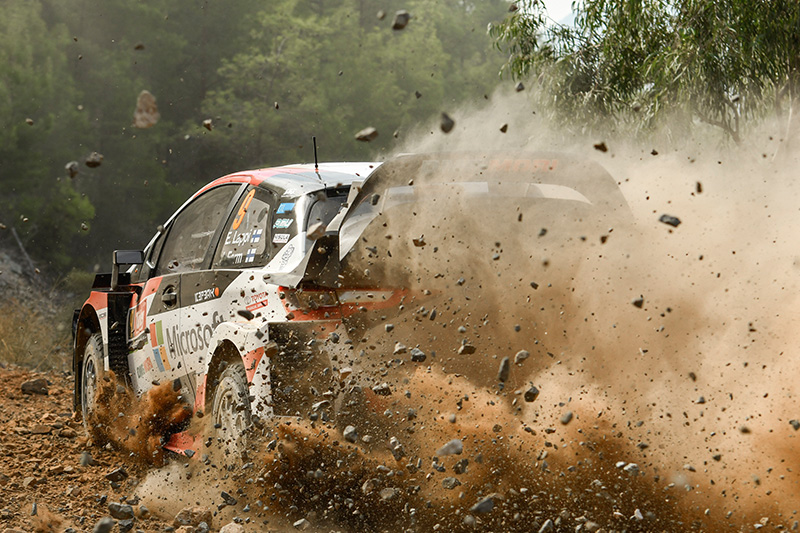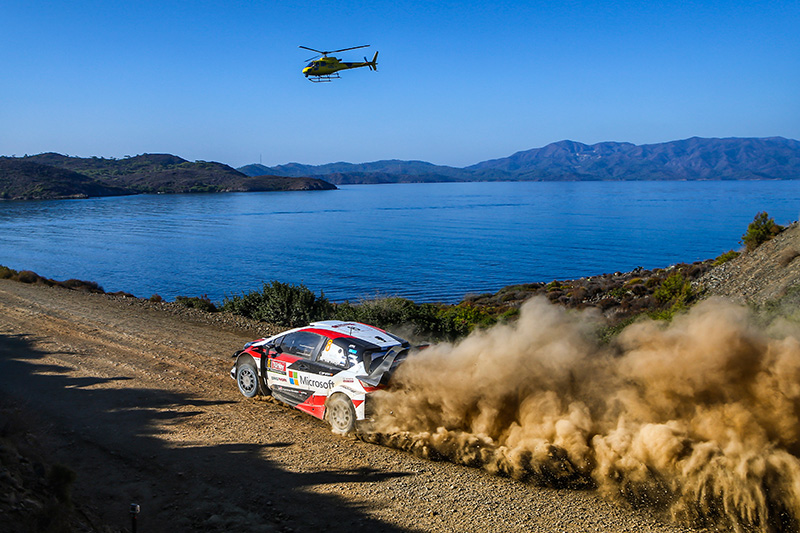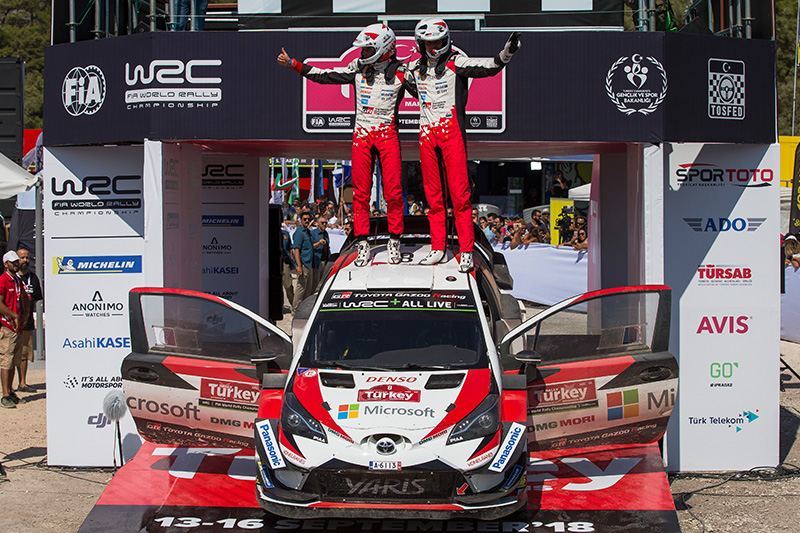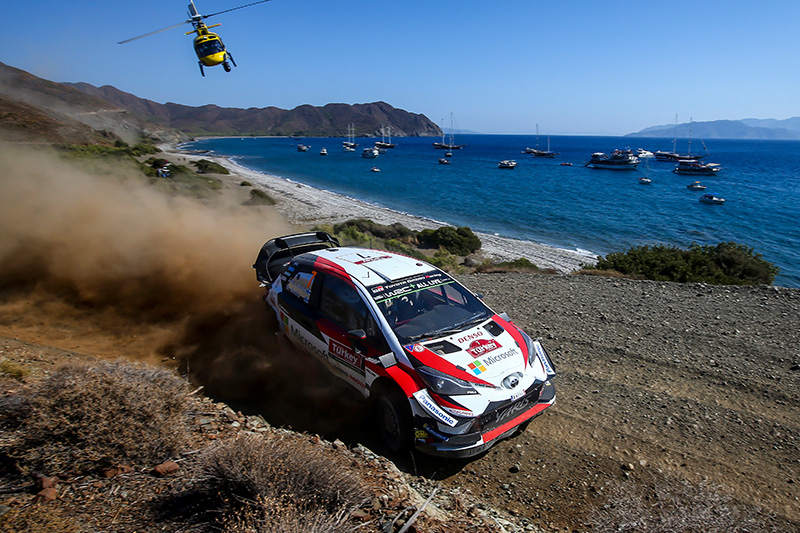RALLYE TURKEY
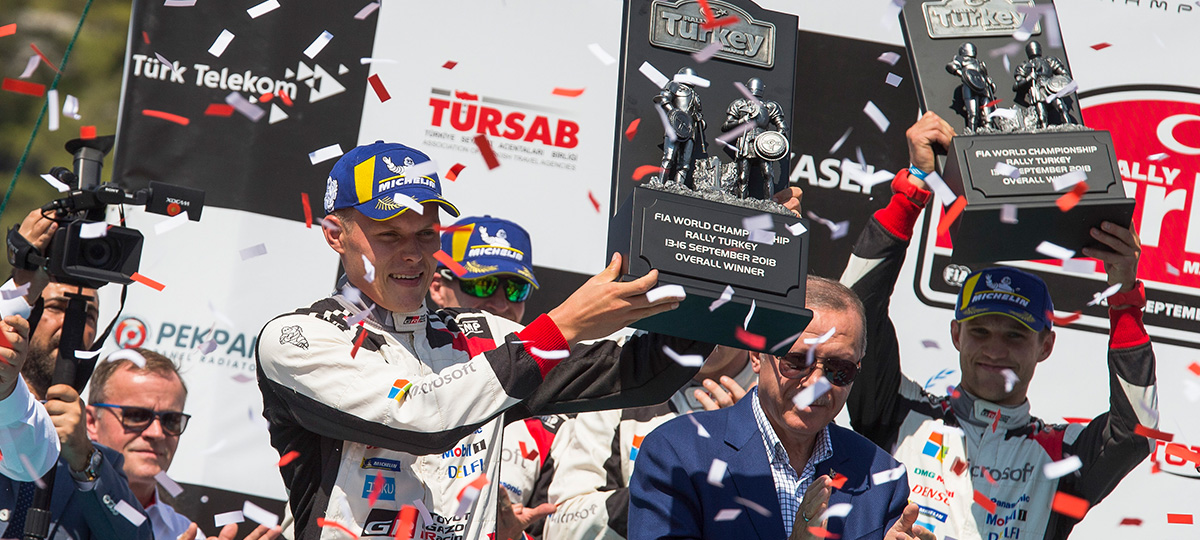
At an unusually rough gravel rally, the Yaris WRC shows its strength
TOYOTA GAZOO Racing secures its first 1-2 finish since its return to the WRC in 2017
The Safari Rally, held in Kenya, Africa, was previously one round of the WRC. It was known as the “car-breaker rally.” Raced on a succession of unimaginably rough gravel roads, car components would break with great frequency; the bodies of the cars would also suffer huge damage. For this reason, many teams would compete with specially prepared cars for the rally—in particular, they would strengthen the bodies and components of their cars, even though this increased their weight.
The Safari Rally was excluded from the WRC calendar from 2003 onwards. However, the Acropolis Rally of Greece and the Cyprus Rally were also gravel rallies that placed great demands on competing cars. Engineers often lamented that car bodies became so deformed at the Cyprus Rally it was impossible for the cars to show their true potential afterwards. Before long, the Acropolis and Cyprus Rallies were also removed from the WRC championships, and only gravel rallies with comparatively smooth road surfaces remained on the calendar. This year’s courses in Argentina, Portugal, and Italy’s Sardegna were rough in places. However, since the roughness affected only parts of the roads, these rallies could not truly be called “rough” gravel rallies.
The WRC returns to Turkey’s dilapidated roads for the first time in eight years
Rally Turkey rejoined the WRC calendar for the first time in eight years, and it turned into an event that could, for the first time in a long time, best be described as a truly “rough” gravel rally. The rally centers around Marmaris in the south-west of Turkey, a scenic seaside resort with a calm atmosphere. However, there are mountains nearby, and the gravel roads that pass through them are extremely rough. Large stones can be found not only on the sides of the roads, but even in the middle. After making their recces (an abbreviation of “reconnaissance,” where drivers check out the courses before the start of the rally), all the drivers shared a heightened sense of danger, saying: “This will be a difficult rally. The first runs may be ok, but by the time of the second runs, stones will have been dug up and make conditions extremely harsh.” It was clear even during the recces that Rally Turkey would turn into a battle for survival.
The TOYOTA GAZOO Racing World Rally Team, whose driver Ott Tänak had won the last two rallies in Finland and Germany, were appearing at Rally Turkey for the first time, and they had made careful preparations. Predicting rough courses, the team conducted tests on similar roads in Portugal. They carried out further development on the suspension and differential gearing of their Yaris WRCs, and set the cars up so that they could demonstrate their true potential even on harsh road surfaces.
Improvements to the cooling system help prevent the engines from overheating
In addition to the difficult road conditions, Rally Turkey was also expected to take place in high temperatures. For this reason, the team made careful developments to their cars’ cooling systems. For two years in a row, extreme heat at the Rally México had caused the temperature of the Yaris WRC engines to rise. The only way to counter this was to reduce engine output, but this resulted in a significant drop in power and the team’s drivers forfeited any chances they might have had for victory. The TOYOTA GAZOO Racing World Rally Team had, of course, been working hard to fix this; however, in order to fully resolve the problem, a significant overhaul of the cooling system was necessary. The team therefore enlisted the help of Denso Corporation, headquartered in Japan, and decided to equip the cars with new, high-performance radiators. These radiators were then shipped to Toyota Motorsport GmbH (TMG), the German subsidiary that was responsible for developing the Yaris WRC engine; there, at the wind tunnels used for the aerodynamic development of the TS050 HYBRID, which competes in the WEC, tests were carried out on the new, Denso-made radiators. Several Japanese engineers from Denso participated in these tests. They equipped the Yaris WRC with a large number of sensors, gathered detailed data, and fed this back into the development process with the aim of achieving optimal cooling performance. After finishing the Rallye Deutschland, the team staff and drivers were also present during these wind tunnel tests, and their expectations for the approaching Rally Turkey were heightened by what they saw.
Despite a lack of speed, the drivers improve their positions through steady driving
As expected, the road surfaces at the start of the rally were extremely rough. In fact, the road conditions were even worse than predicted during testing and, in order to avoid being negatively affected, the team was forced to raise the car height of the Yaris WRC as much as possible. But, in part due to this increase in car height, the car’s tires were no longer able to grip the road sufficiently, leading to a lack of traction. The first gravel road stages took place on Day 2, but the team’s drivers were unable to achieve the time records they wanted: Jari-Matti Latvala was 16.3 seconds off the top in fourth place; Ott Tänak was 31.9 seconds behind in fifth; while Esapekka Lappi was some 36.8 seconds back in seventh.
However, the drivers kept their cool despite the disappointing results. Tänak commented: “Rather than outright speed, the car’s reliability and driving steadily without making mistakes is the key to this rally. If we can continue driving at our own pace, something might happen.” Latvala, who is a former winner of the Acropolis Rally, was of the same opinion. He fully understood that on rough gravel roads such as at Rally Turkey, driving intelligently and minimizing damage to one’s cars was of the greatest importance.
On Day 3, Tänak and Latvala were able to demonstrate the correctness of their approach. The top three drivers in Turkey suffered severe damage to their suspension, and were either forced to retire or lose a lot of time on repairs. The TOYOTA GAZOO Racing World Rally Team, on the other hand, despite not fully solving the problem of insufficient traction, had found the ideal car height settings and succeeded in improving the car’s handling. As a result, Tänak secured 2 and Latvala 1 stage wins on Day 3. As the leading drivers fell out of contention, Tänak rose to first in the overall rally standings, with Latvala 13.1 seconds behind in second place. Lappi, however, drove out of bounds on SS10 due to inaccurate corner information in his pace notes. He was initially stuck on the side of the road, but his car then slid down a slope, suffered damage, and he was unfortunately forced to retire.
TOYOTA GAZOO Racing secures its first 1-2 finish since its return to the WRC, and takes the overall championship lead
As Tänak had predicted, Rally Turkey turned into a battle for survival—something of a rarity in recent years. Many of the top drivers abandoned the rally on Day 3. Going into the final day, there was a gap of almost a minute between Latvala in second and the driver in third place, so it was extremely unlikely he would be caught. In addition, given how short the remaining Special Stages were, and given the time gap to Tänak in first place, it would have been a significant risk to attack and attempt to overhaul his teammate. Latvala chose to respect the position of Tänak—who has a strong chance of winning the drivers’ championship—and aimed instead for a 1-2 team finish. To this end, the Finn made clear his intention to defend second place on the final day.
Tänak and Latvala managed to safeguard their positions on Day 4, so giving the team its first 1-2 finish since its return to the WRC in 2017. On the final Power Stage, which rewards drivers with bonus championship points, Tänak placed third and Latvala fourth. As a result of these additional points, Tänak rose to second in the championship standings, with Latvala moving up to fifth. In addition, the 1-2 finish enabled the TOYOTA GAZOO Racing World Rally Team to gain the maximum possible manufacturer points, and the team now stands at the top of the manufacturers’ championship.
Rally Turkey was an extremely challenging event, and it was only because the team worked together and combined their strength that it was able to achieve such a positive result. As predicted, the rally also took place in high temperatures and at low speeds, which placed severe stress on the Yaris WRC engines. However, the new radiators—which were jointly developed by Denso and TMG, using the latter’s wind tunnel—continued to provide outstanding cooling performance to the very end of the rally. It seems that the problems with the cooling system, which had been a weak point of the Yaris WRC, have for the time being been resolved.
TOYOTA GAZOO Racing must improve in many areas if they want to compete for the championship title
On the other hand, going forwards a number of issues remain. The problem of insufficient traction on bad roads was not fully resolved, and the Yaris WRC lacked the speed of its rivals. The next round of the WRC, Rally GB (Great Britain), will be held on low-grip surfaces, and the team struggled there last year. If it wants to continue fighting for the championship until the end of the season, then the TOYOTA GAZOO Racing World Rally Team will have to improve its traction at all costs. In addition, Latvala’s Yaris WRC had a problem with powertrain hydraulics for the second rally in succession. The team had installed a back-up system after the Rallye Deutschland, and this enabled the car to continue to the end; however, it is clear that further improvements are necessary.
A number of other minor problems also afflicted the cars at Rally Turkey, so the victory was not as clear-cut as it might have appeared. The team wants to create a car that operates trouble-free in all situations, and that is capable of performing to its full potential at all times—but in order to do this, there are still a large number of improvements to be made. The TOYOTA GAZOO Racing World Rally Team was fortunate enough to secure an outstanding result at Rally Turkey, but the event showed that all team members will have to work even harder if they want to achieve their goal of creating an ever-better car.
RESULT
| Pos | Driver | Co-Driver | Vehicle | Time |
|---|---|---|---|---|
| 1 | Ott Tänak | Martin Järveoja | Toyota Yaris WRC | 3h59m24.5s |
| 2 | Jari-Matti Latvala | Miikka Anttila | Toyota Yaris WRC | +22.3s |
| 3 | Hayden Paddon | Seb Marshall | Hyundai i20 Coupe WRC | +1m46.3s |
| 4 | Teemu Suninen | Mikko Markkula | Ford Fiesta WRC | +4m10.9s |
| 5 | Andreas Mikkelsen | Anders Jaeger | Hyundai i20 Coupe WRC | +7m11.7s |
| 6 | Henning Solberg | Ilka Minor | Skoda Fabia R5 | +13m40.6s |
| 7 | Jan Kopecky | Pavel Dresler | Skoda Fabia R5 | +18m25.2s |
| 8 | Simone Tempestini | Sergiu Itu | Citroen C3 R5 | +19m37.1s |
| 9 | Chris Ingram | Ross Whittock | Skoda Fabia R5 | +20m21.3s |
| 10 | Sebastien Ogier | Julien Ingrassia | Ford Fiesta WRC | +20m51.2s |
| Retired | Esapekka Lappi | Janne Ferm | Toyota Yaris WRC |

